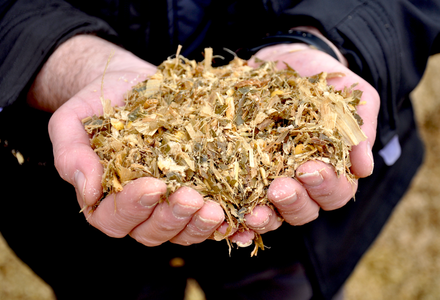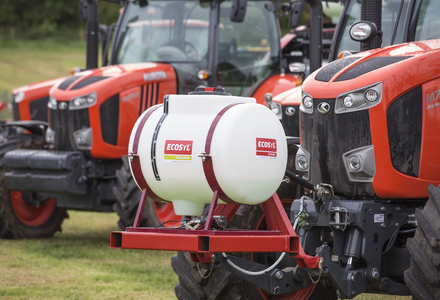Preserving the milk value of maize
09 September 2019
Want more milk from your maize silage? The microbial processes in maize clamps have a huge impact on its nutritional value. So, understanding them is key.
Picture the scene – trailers full of freshly-harvested maize entering your farmyard. But every so often, rather than unloading the sweet-smelling forage into your clamp, two or three out of every 10 trailers simply peel off and dump it in the slurry pit, rendering it worthless. Far-fetched?
According to Volac silage microbiologist, Dr Mark Leggett, this is about the scale of loss that can occur in maize clamps through a combination of inefficient fermentation and aerobic spoilage (heating). Both are caused by unwanted micro-organisms, as Dr Leggett explains.
A lot of investment goes into growing a maize crop so there is no point in letting its nutritional value go to waste.
_1__portrait.jpg?1567684623) Hidden losses in the clamp
Hidden losses in the clamp
Worryingly, Dr Leggett says it is not just detectable problems, such as heating and visible wastage, that cause losses. A clamp may look fine but suffer from substantial hidden losses.
Equally, it is not just tonnes of dry matter at stake. The feed quality of the silage that remains will be depleted, and fungal contamination can make silage unpalatable, leading to cows rejecting it, he adds. So what can be done?
Firstly, Dr Leggett says it is important to really understand the unwanted microbial processes, so you can focus on controlling them.
He explains:
Fermentation losses, which are typically about 8%, or roughly equal to one trailer load in 10 being lost, occur because the primary fermentation is simply not efficient enough. This is important because fermentation is essentially the ‘pickling’ process that preserves the silage.
Meanwhile, losses from aerobic spoilage, which can reach 20% or two trailer loads in 10, are caused when yeasts and moulds that are present naturally on maize plants are allowed to survive in the clamp and proliferate on exposure to air. This leads to heating, as the energy in the maize is ‘burned up’. Alternatively, if you see mould growth, losses are likely to be even higher.
To give maize the best protection, Dr Leggett urges farmers to tackle both problems before irreversible damage is done.
Improve fermentation
A key step to successful ensiling, says Dr Leggett, is the rapid production of acidic conditions (low pH) in the clamp.
This process of fermentation is carried out by lactic acid bacteria, he says, and is important in order to quickly inhibit spoilage bacteria. However, not all lactic acid bacteria are the same.
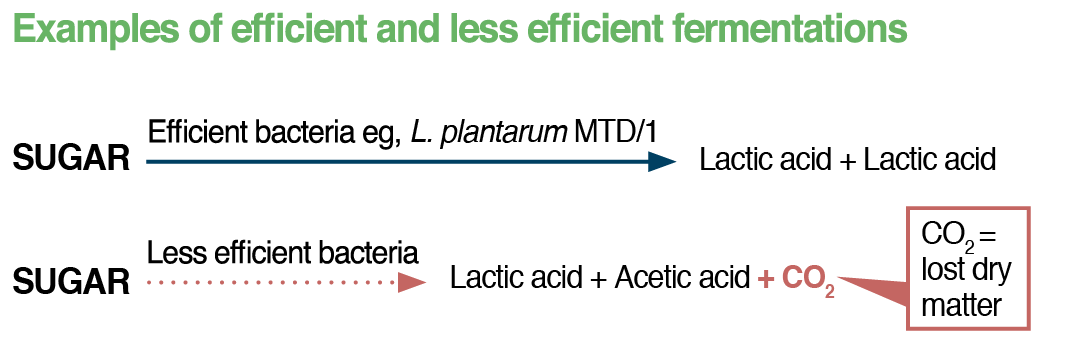
“While some bacteria will ferment the sugars in maize purely to beneficial lactic acid, others will also ferment the sugars to other materials. These include carbon dioxide, which is not good because the carbon in carbon dioxide is a direct loss of dry matter.
“While you cannot control the types of bacteria naturally present on the crop at harvest, you can do various things to set maize up for a better preservation.
You can also take better control of the process by adding beneficial bacteria to dominate the fermentation.
By applying a quality additive in this way, it not only provides beneficial bacteria but also a strain of them, such as Lactobacillus plantarum MTD/1, specially-selected to be highly efficient at lactic acid production.
“By achieving a more efficient fermentation, the benefits can include lower dry matter losses and faster inhibition of unwanted spoilage bacteria,” he points out.
Tackle aerobic spoilage
Unfortunately, no matter how efficient the fermentation, it cannot inhibit all spoilage micro-organisms in maize clamps, explains Dr Leggett.
This is because certain yeasts can survive in low pH conditions, he says, and then grow on lactic acid when the clamp is exposed to air – causing aerobic spoilage.
“By feeding on the lactic acid, they reduce the silage’s dry matter through production of carbon dioxide and release of heat. But also, because lactic acid is being used up, the pH rises again.
“This allows other fungi, such as Aspergillus and Penicillium, to grow. Other consequences include reductions in nutritional value and palatability, and potentially mycotoxin production.”
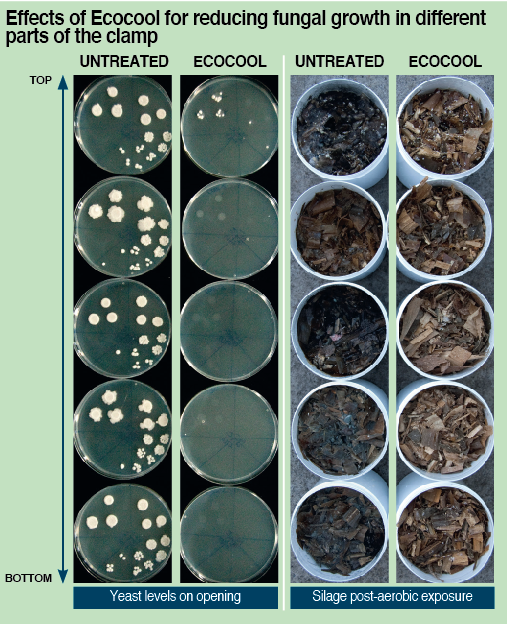
Just as with naturally-occurring bacteria on maize, Dr Leggett says farmers have little control over the numbers of these yeasts present on the crop at harvest. What is achievable, however, is to limit their growth in the silage.

You do this with best practice clamp filling followed by good consolidation and sealing to deprive them of air.
Similarly, you can put yourself in much better control by including something to inhibit them. This can be a preservative-based chemical, such as sorbate, or an additional beneficial bacterial strain, such as Lactobacillus buchneri, which generates acetic acid that has anti-yeast properties.
As an example, the dual-acting additive Ecocool contains the PJB/1 strain of Lactobacillus buchneri. It also contains Lactobacillus plantarum MTD/1, which is proven to produce a rapid fermentation.
Treatment with Ecocool has been shown to both reduce yeast level and keep silage taken out of the clamp cool and stable for more than 10 days.
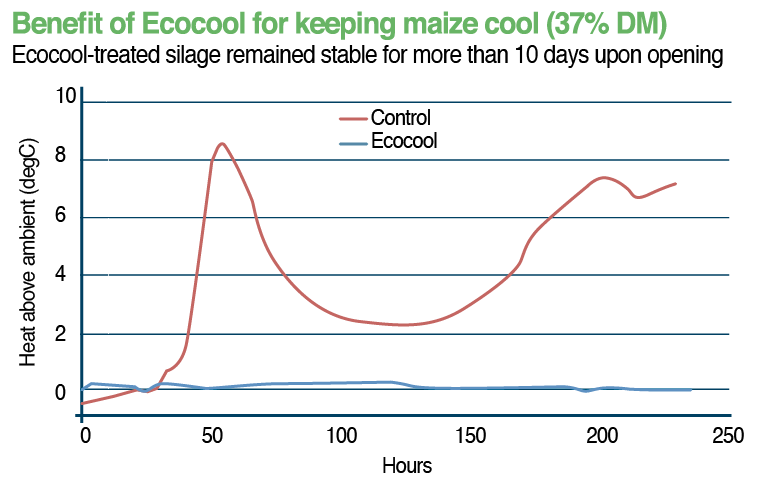
Want to find out more about Ecocool? Download the full product brochure today.
Setting up maize for better preservation
- Harvest the crop at 30-33% dry matter – it optimises starch content and, by avoiding it being too dry, it makes the crop easier to consolidate to remove air
- Don’t cut too low – the base of the crop contains more mould spores, which contribute to aerobic spoilage (heating)
- Consider a chop length of 1.5-2cm to aid consolidation
- Make use of a dual-acting additive to improve fermentation and control heating by inhibiting yeasts and moulds
- Fill clamps in horizontal layers a maximum of 15cm deep – the most that can be consolidated effectively
- Compact to a density of 700kg of fresh maize per cubic metre and sheet thoroughly to create an airtight seal
Want to find out more about how you can make the most of your maize? Download our handy Cut to Clamp guide today, or visit the Cut to Clamp website for more top tips and advice.
_listing.png?1625570203)
